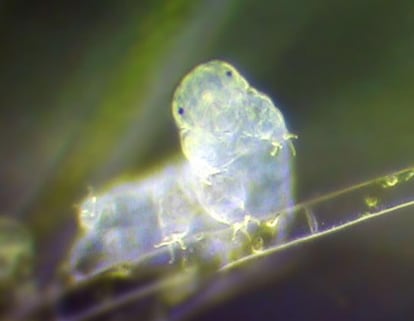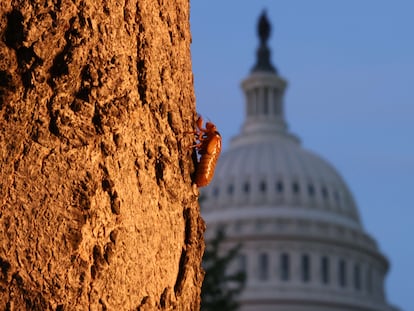Tiny water bears can stand being shot at speeds faster than a bullet...but not a Moon crash
New research concludes the microscopic beings on a spacecraft that went down in 2019 did not survive the impact, but the findings help shed light on the origins of life in the universe

Tardigrades, also known as water bears, are microscopic beings capable of surviving nearly everything: freezing temperatures, boiling water, decades without food. Even being shot out of a gun. But a Moon crash is too much even for these sturdy creatures, which are tipped to be the only survivors on Earth if there is a mass extinction event given their amazing resilience. Now a new study has subjected water bears to a literal trial by fire: the tardigrades were shot at extremely high speeds to see whether they could survive the impact.
The question was not theoretical: two years ago, US millionaire Nova Spivac decided to send thousands of tardigrades to the Moon on Israel’s Beresheet spacecraft as part of a so-called “lunar library.” The mission, organized by Spivac’s NGO Arch Mission Foundation, was aimed at creating a “backup of planet Earth” on the Moon. The tardigrades, which are smaller than half a millimeter in size, were sent in a dehydrated dormant state, with their metabolism curtailed to 0.01% of normal. And that’s how they remained after the privately funded spacecraft crash-landed on the Moon in 2019. There were no plans to rescue them or find out whether they could be rehydrated and resuscitated after the impact.
The crash caused a small scandal: it was yet another example of the risk of biological contamination in the solar system due to the negligence of new space actors. But Spanish scientist Alejandra Traspas, a PhD student at Kent University at the time, wondered what happened to the tardigrades after the accident. “I thought: ‘Poor things, would they have survived?” she tells EL PAÍS by phone.

This question led her to design an experiment to shoot water bears at the extreme speeds they would have faced during the Moon crash landing. For the experiment, a sand target was placed inside a vacuum chamber to simulate the conditions in space and the impact on the surface of a rocky planet. Traspas and her research partner Mark J. Burchell then fired the water bears at the target from a “three-meter mega cannon,” says Traspas, alluding to the two-stage light gas gun that was used. Between two and three tardigrades, which usually live in humid conditions, were placed in the gun at a time in a frozen state of induced hibernation. The tests began at the end of 2019, following the crash, and continued, with the exception of one break, throughout the coronavirus pandemic.
The results of the study, published in the journal Astrobiology, highlight the amazing resilience of the water bears, but recognize that even the tough tardigrades have their limit. When the species were fired at extremely high speeds – faster than the speed of a bullet – the water bears resisted the impact and were able to recover from hibernation, although at a slower speed than the control group (the water bears which were frozen but not fired). After being shot out at the speed of nearly one kilometer per second, the tardigrades survived. But above this threshold, they disintegrated. And that is what would have happened to the tardigrades aboard the Beresheet lunar lander, says Traspas. “We are able to confirm that they did not survive,” she explains. “The speed of the impact with the Moon was not that great, but the shock pressure of the impact due to the material of the spacecraft is so great that it’s impossible that they were able to withstand it.”
We are able to confirm that the tardigrades did no survive the 2019 Moon crash-landingSpanish scientist Alejandra Traspas
Traspas, who is now completing her PhD degree at Queen Mary University in London, is planning to continue to shoot tardigrades to solve a question that came up during the study: why did the water bears that survived being fired from the cannon stop reproducing? “We are going to repeat the experiment, but with a genetic analysis to see if it’s related to natural selection, stress or if there is genetic damage,” explains Traspas.
More than just highlighting the resilience of these small creatures, the study has implications for understanding the origins of life. To explain the existence of living beings, one hypothesis argues that there is life in the universe and that it travels on asteroids and other celestial bodies until coming into contact with life-friendly planets such as Earth. But the tardigrade research challenges this idea, since it shows that even these hardy beings would not survive such a great impact. “The possibility is more complicated, but it is not impossible,” says Traspas. “You have to take into account the angle of the impact and other conditions.”
The calculations from the study will allow other scientists to consider the possible transfer of microorganisms between the Earth and the Moon or between Mars and its satellite Phobos. It also has implications for the search for life in Enceladus, one of Saturn’s moons, where microscopic organisms are thought to be living in its oceans. A spacecraft that were to cross one of its kilometer-long geysers could collect samples without the impact being fatal for the specimens.
English version by Melissa Kitson.
Tu suscripción se está usando en otro dispositivo
¿Quieres añadir otro usuario a tu suscripción?
Si continúas leyendo en este dispositivo, no se podrá leer en el otro.
FlechaTu suscripción se está usando en otro dispositivo y solo puedes acceder a EL PAÍS desde un dispositivo a la vez.
Si quieres compartir tu cuenta, cambia tu suscripción a la modalidad Premium, así podrás añadir otro usuario. Cada uno accederá con su propia cuenta de email, lo que os permitirá personalizar vuestra experiencia en EL PAÍS.
¿Tienes una suscripción de empresa? Accede aquí para contratar más cuentas.
En el caso de no saber quién está usando tu cuenta, te recomendamos cambiar tu contraseña aquí.
Si decides continuar compartiendo tu cuenta, este mensaje se mostrará en tu dispositivo y en el de la otra persona que está usando tu cuenta de forma indefinida, afectando a tu experiencia de lectura. Puedes consultar aquí los términos y condiciones de la suscripción digital.
More information
Archived In
Últimas noticias
Can cheese protect brain health? This is what the science says
Maude Apatow, from acting in ‘Euphoria’ to directing: ‘There are many films that you can tell weren’t written by someone young’
The life of a delivery driver in China: ‘Many people don’t know how an order can arrive at their home in just one day’
The guardians of the meteorites of the Argentine Chaco
Most viewed
- Christian Louboutin: ‘Young people don’t want to be like their parents. And if their parents wear sneakers, they’re going to look for something else’
- US sanctions against jailed cartel leader ‘El Marro’ highlight Mexico’s lack of control over its prisons
- Cartels in Mexico take a leap forward with narco-drones: ‘It is criminal groups that are leading the innovation race’
- Liset Menéndez de la Prida, neuroscientist: ‘It’s not normal to constantly seek pleasure; it’s important to be bored, to be calm’
- ‘El Limones’ and the growing union disguise of Mexican organized crime











































